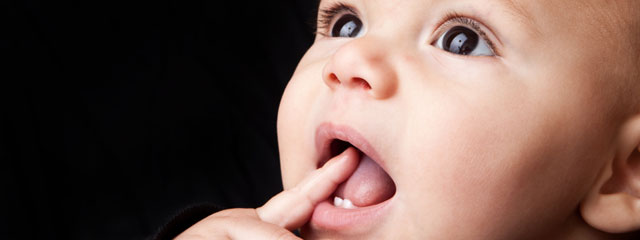 Your child’s first teeth will begin coming in between three and sixteen months (usually around six months). The two bottom front teeth will be the first to come in and this will be followed by the four upper teeth in four to eight weeks. Your child will continue to get new teeth until he has all twenty of his primary teeth when he is three years old, with most children getting about four new teeth every four months. In most children teething only causes increased drooling and a desire to chew on hard things, but in some it does cause mild pain and irritability and the gums may become swollen and tender. To help this you can vigorously massage the area for a few minutes or let him chew on a smooth, hard teething ring. Teething should not cause fever, diarrhea, sleeping problems or diaper rashes and most children do not need teething gels or treatment with Tylenol for pain, although you can use them if necessary.
Your child’s first teeth will begin coming in between three and sixteen months (usually around six months). The two bottom front teeth will be the first to come in and this will be followed by the four upper teeth in four to eight weeks. Your child will continue to get new teeth until he has all twenty of his primary teeth when he is three years old, with most children getting about four new teeth every four months. In most children teething only causes increased drooling and a desire to chew on hard things, but in some it does cause mild pain and irritability and the gums may become swollen and tender. To help this you can vigorously massage the area for a few minutes or let him chew on a smooth, hard teething ring. Teething should not cause fever, diarrhea, sleeping problems or diaper rashes and most children do not need teething gels or treatment with Tylenol for pain, although you can use them if necessary.
You should begin cleaning your child’s teeth by wiping them with a moist washcloth or a soft child’s toothbrush, but use a pea-size amount of a fluoride toothpaste or a non-fluoride toothpaste (like Baby OraGel) until your child is able to spit it out (too much fluoride can stain their teeth). Also, do not put your child to sleep with a bottle, since the sugar in the milk will pool around their teeth all night and cause cavities.





